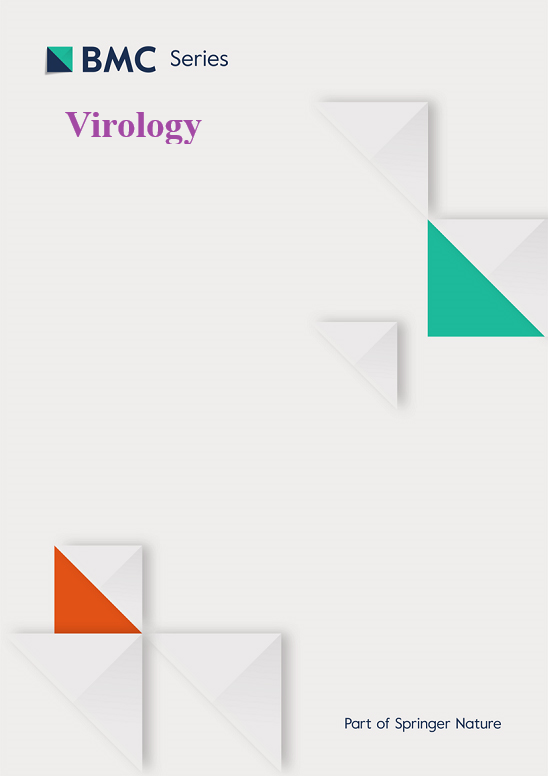肽模拟物对包膜病毒的协同作用
IF 2.8
3区 医学
Q3 VIROLOGY
引用次数: 0
摘要
病毒对全球健康的影响突出表明迫切需要创新的抗病毒战略。本研究研究了两种基于蒽酰胺的肽模拟物(RK610和RK758)联合使用,以及一种肽模拟物(RK610)与阳离子肽Mel4和三聚亚胺联合使用对小鼠肝炎病毒(一种冠状病毒;MHV-1)、流感病毒(H1N1)和单纯疱疹病毒(HSV-1)。棋盘格实验表明,RK610+RK758对MHV-1和H1N1具有协同作用(∑FICI值分别为0.14和0.5),而RK610+Mel4对HSV-1具有强协同作用(∑FICI = 0.18)。协同处理优于顺序应用。透射电镜证实了病毒粒子的结构损伤,而细胞毒性试验表明,除了三聚亚胺和RK610+三聚亚胺对A9细胞无毒外,所有测试的组合对MDCK、A9和Vero细胞无毒。使用DOPC(100%)和DOPC: POPS(70:30)脂质进行生物物理分析,为研究肽模拟与脂质膜的相互作用提供了机制思路。拴系双层脂质膜(tBLMs)结合电阻抗谱显示,无论脂质成分如何,肽模拟物及其组合都降低了膜的电导。石英晶体微平衡耗散监测(QCM-D)显示,RK610和RK758在外层引起质量增加,随POPS显著增加。在DOPC中,RK610增加了Langmuir-Blodgett槽的表面压力,而RK758则降低了表面压力。610+ 758和610+Mel4组合提高了最大压力。在DOPC + POPS中,RK758使单层不稳定(35 mN/m,无平台),而组合则恢复稳定性。这些发现强调了肽模拟物作为广谱抗病毒药物,对靶向病毒包膜具有协同作用,为更安全和低耐药性的治疗铺平了道路。本文章由计算机程序翻译,如有差异,请以英文原文为准。
Synergistic effects of peptide mimics against enveloped viruses
The global health impact of viruses highlights the urgent need for innovative antiviral strategies. This study investigated the synergistic potential of two anthranilamide-based peptide mimics (RK610 and RK758) in combination, and one peptide mimic (RK610) in combination with the cationic peptides Mel4 and melimine, against murine hepatitis virus (a coronavirus; MHV-1), influenza virus (H1N1), and Herpes simplex virus (HSV-1). Checkerboard assays demonstrated RK610+RK758 had synergy against MHV-1 and H1N1 (∑FICI values of 0.14 and 0.5, respectively), while RK610+Mel4 showed potent synergy against HSV-1 (∑FICI = 0.18). Co-treatment outperformed sequential application. Transmission electron microscopy confirmed structural damage to virions, while cytotoxicity assays indicated that all tested combinations were non-toxic in MDCK, A9, and Vero cells, except for melimine and RK610+melimine with A9 cells. Biophysical analyses using DOPC (100 %) and DOPC: POPS (70:30) lipids provided mechanistic ideas into peptide-mimic interactions with lipid envelopes. Tethered bilayer lipid membranes (tBLMs) in conjunction with electrical impedance spectroscopy revealed that both peptide mimics and their combinations reduced membrane conductance, regardless of lipid composition. Quartz crystal microbalance with dissipation monitoring (QCM-D) revealed that RK610 and RK758 induced mass addition at the outer layer, significantly increasing with POPS. In DOPC, RK610 increased the surface pressure in a Langmuir-Blodgett trough while RK758 reduced it. The 610 + 758 and 610+Mel4 combinations raised maximum pressures. In DOPC + POPS, RK758 destabilized the monolayer (35 mN/m, no plateau), whereas combinations restored stability. These findings highlight peptide mimics as broad-spectrum antiviral agents that show synergy to target viral envelopes, paving the way for safer and low-resistance therapeutics.
求助全文
通过发布文献求助,成功后即可免费获取论文全文。
去求助
来源期刊

Virology
医学-病毒学
CiteScore
6.00
自引率
0.00%
发文量
157
审稿时长
50 days
期刊介绍:
Launched in 1955, Virology is a broad and inclusive journal that welcomes submissions on all aspects of virology including plant, animal, microbial and human viruses. The journal publishes basic research as well as pre-clinical and clinical studies of vaccines, anti-viral drugs and their development, anti-viral therapies, and computational studies of virus infections. Any submission that is of broad interest to the community of virologists/vaccinologists and reporting scientifically accurate and valuable research will be considered for publication, including negative findings and multidisciplinary work.Virology is open to reviews, research manuscripts, short communication, registered reports as well as follow-up manuscripts.
 求助内容:
求助内容: 应助结果提醒方式:
应助结果提醒方式:


